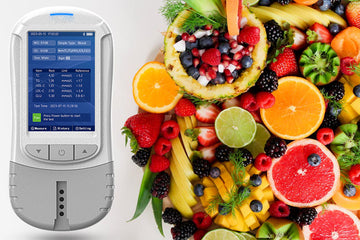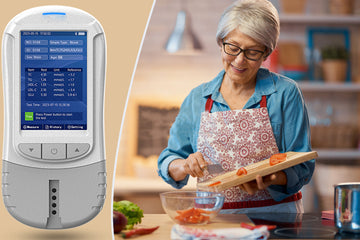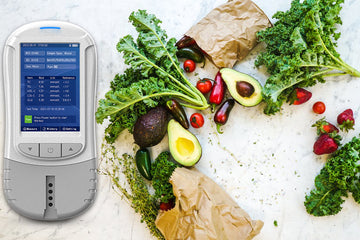Home Care Medical Products
What to Eat and Avoid on a High Cholesterol Diet
by len king on Mar 11, 2024

"Knowing what to eat for high cholesterol (hypercholesterolemia) is important for your heart health, and a high cholesterol diet is specifically designed to lower cholesterol levels.
Not all cholesterol is created equal:
High-density lipoprotein (HDL) helps your body remove cholesterol from the blood.
High levels of low-density lipoprotein (LDL) cause plaque buildup (atherosclerosis).
When you have high cholesterol, the diet recommended for you will include foods that help increase HDL (good) cholesterol and lower LDL (bad) cholesterol.
In this article, you will learn how to change your diet and what foods you should eat, limit or avoid if you have high cholesterol.
I. What to eat for high cholesterol
Focus on foods that are high in soluble fiber, plant sterols and protein. Swap foods high in saturated or trans fats for foods containing unsaturated fats.
1. Foods to eat
Spinach, lettuce, kale
Kiwi fruit, oranges, grapefruit, apples, pears, plums, grapes, turnips,
Beets, turnip greens, cucumbers, celery, peppers
Avocado, high fiber whole grains, barley, muesli, bulgur, quinoa
Lentils, brown rice, turkey, tofu, chicken
Halibut, cod, tilapia, tuna, salmon
Egg whites or egg substitute
Almonds, walnuts, sesame and pumpkin seeds, sterol/sterol-fortified foods
2、Foods to limit or avoid
Beef, liver, sausage, bacon, ham, duck, goose, beef jerky, salami, canned fish in oil, hot dogs, shellfish, shrimp, pork, egg yolks, gravy, milk, cheese, full-fat yogurt, doughnuts, pastries, cookies, cakes, packaged recreational foods, ice cream, pudding, cream sauces, soft drinks, sweetened fruit juices, deep-fried foods/fast foods, coconut oil, palm kernel oil, butter, lard, shortening, Partially hydrogenated or hydrogenated vegetable oil, buttered popcorn, potato chips, pretzels, alcohol (mixed drinks, cocktails)
3. Fruits and Vegetables
Plants don't contain any dietary cholesterol, so you don't have to limit fruits and vegetables in your diet.
Fruits and vegetables are nutritious and rich in fiber and phytosterols (healthy chemicals that help control LDL levels).
Salads are typically preferred, but be careful what you add on top.
To give salads fat-lowering benefits, skip extras like dressing and bacon.
Opt for a mixture of leafy greens, lean proteins and seeds.
2. Whole grains
Soluble fiber reduces the amount of cholesterol you absorb and lowers LDL.
Whole grains (bread, flour, rice) are usually higher in fiber than refined foods. Oats and oat bran are particularly good choices.
However, check food labels for fiber, total carbohydrates, and sugar content.
Some prepared grains may contain added sugars.
3. Lean protein
You can eat meat on a fat-lowering diet, but be careful about the type of meat you eat.
Previously, the advice was to avoid red meat in favor of lean white meat.
However, a 2019 study published in the American Journal of Clinical Nutrition found that there wasn't much of a difference between the effects of red and white meat on cholesterol levels.
Fish like halibut, tilapia and cod are low in fat and carbohydrates and high in protein.
Tuna and salmon also contain omega-3 fats, which are healthy fats that help lower triglyceride levels.
3. Nuts and seeds
All fats are not created equal, and saturated fats, especially those high in LDL, can negatively affect blood lipid levels.
Healthy fats such as nuts and avocados can help lower cholesterol levels by raising HDL.
Nuts, seeds and oils rich in linolenic acid (an omega-3 fat) can lower blood lipid levels.
Walnuts, pecans, almonds and pistachios are rich in omega-3 fats and fiber.
These foods are high in calories, so eat them in moderation.
5, beans and legumes
Beans and legumes are high-protein, low-fat foods that can have a huge impact on your blood lipid levels.
They are versatile and nutritious. In addition, the protein they contain tends to create a feeling of fullness.
Most legumes have a fairly neutral flavor and are suitable for different dishes, including soups, salads, side dishes, dips, and entrees.
6. Dairy
Choose skim milk and yogurt over whole milk. Cheese is often rich in saturated fat, but small amounts of low-fat cheeses (such as mozzarella) are a healthy choice.
Single-serving cheese slices or cheese sticks work well, especially as a quick snack.
7. Desserts
Avoid sweets made with whole milk, butter and sugar.
Many packaged cakes, cookies and snacks contain trans fats.
These fats raise ""bad"" cholesterol and lower ""good"" cholesterol.
Instead, bake your own low-cholesterol desserts using fruit, egg whites and oats.
8. Beverages
Herbal and green teas may help lower cholesterol.
Citrus juices may also have a beneficial effect on cholesterol levels.
Alcoholic beverages, especially mixed drinks and cocktails, may be a source of extra calories and sugar and can increase triglycerides.
Cooking tips for high cholesterol
When preparing meals, you can reduce the fat content of meat by:
(1) choosing lean meats with no visible fat
(2) Removing any remaining fat or cartilage from the meat and removing the skin before serving
(3) Roasting, grilling or baking meat rather than frying it in high-fat butter or oil
(4) For fruits and vegetables, avoid adding too much salt, sugar, butter or canola oil. To avoid weakening their nutritional value, avoid adding sweet sauces, fats or oils to beans and legumes.
(5) Add spices for flavor. In addition to being delicious, many popular herbs and spices have properties that can alter the way LDL cholesterol interacts with free radicals - free radicals that can destabilize molecules in LDL, which can cause inflammation and further impact cardiovascular health.
The antioxidants in some fresh herbs and spices may block these harmful interactions.
Garlic is another healthy and versatile choice for a delicious meal that may help lower cholesterol and triglyceride levels.
When baking, try adding ginger, allspice and cinnamon.
These are rich in antioxidants.
Instead of using lard, butter or oil for baked goods, try alternatives such as applesauce, bananas or avocados.
When to eat
If you are planning to change your diet, consider the parts of your life that may be affected.
Your lifestyle, responsibilities and preferences can also affect your ability to make and stick to changes.
(1) General Nutrition
A high cholesterol diet can be varied and balanced compared to a diet that severely restricts the foods you can eat.
Fresh produce, lean meats, and low-fat dairy products are all approved by the program and are part of anyone's healthy diet.
Many of the foods you may want to avoid or limit on a low cholesterol diet are high in fat, sugar and calories.
In addition to controlling cholesterol, restricting or avoiding these foods has other health benefits, such as controlling blood sugar or lowering blood pressure.
(2) Flexibility
While you may need to expand your typical shopping list and modify some favorite recipes, the wide variety of high-cholesterol foods makes your plan very flexible.
Many restaurant menus highlight heart-healthy or low-fat options, which may be appropriate.
You can also ask for simple swaps, such as whole wheat wraps instead of bread or grilled chicken instead of fried.
(3) Control your diet
If you are unsure how to make a low-cholesterol diet fit your dietary needs and preferences, you may want to consult a registered dietitian or nutritionist. They can guide you in developing a lipid-lowering meal plan.
This advice may be especially helpful if you're also dealing with gastrointestinal issues worsened by fiber or roughage, or if you need to avoid gluten (millet, paintbrush, and quinoa are fiber-rich gluten-free options).
Side effects
A cholesterol-lowering diet shouldn't have any side effects. You may experience temporary intestinal symptoms such as constipation whenever you change your diet, but these are usually temporary and will get better as you adjust.
If you also start taking cholesterol-lowering medication, keep in mind that any side effects you experience may also be caused by your medication.
For example, muscle pain and weakness are common side effects of statins.
Talk to your healthcare provider about anything worrisome you're experiencing.
Overall Health
Recommended foods high in cholesterol offer many other health benefits.
Two in particular - helping you maintain a healthy weight and boosting your energy - can make other changes, such as exercising more, easier to adopt.
This can obviously help you lower your cholesterol, but it will also help reduce your risk of problems other than cardiovascular disease, including cancer.
Eating a heart-healthy diet rich in fresh produce, whole grains, and lean proteins, while avoiding foods that are heavily processed and high in trans fats, can improve your cholesterol and triglyceride levels, and may even help you with other heart disease risk factors, such as your weight.
You need to discuss different cholesterol-lowering methods with your health care provider.
While dietary changes can help, you may also need medications to help control your levels."
Not all cholesterol is created equal:
High-density lipoprotein (HDL) helps your body remove cholesterol from the blood.
High levels of low-density lipoprotein (LDL) cause plaque buildup (atherosclerosis).
When you have high cholesterol, the diet recommended for you will include foods that help increase HDL (good) cholesterol and lower LDL (bad) cholesterol.
In this article, you will learn how to change your diet and what foods you should eat, limit or avoid if you have high cholesterol.
I. What to eat for high cholesterol
Focus on foods that are high in soluble fiber, plant sterols and protein. Swap foods high in saturated or trans fats for foods containing unsaturated fats.
1. Foods to eat
Spinach, lettuce, kale
Kiwi fruit, oranges, grapefruit, apples, pears, plums, grapes, turnips,
Beets, turnip greens, cucumbers, celery, peppers
Avocado, high fiber whole grains, barley, muesli, bulgur, quinoa
Lentils, brown rice, turkey, tofu, chicken
Halibut, cod, tilapia, tuna, salmon
Egg whites or egg substitute
Almonds, walnuts, sesame and pumpkin seeds, sterol/sterol-fortified foods
2、Foods to limit or avoid
Beef, liver, sausage, bacon, ham, duck, goose, beef jerky, salami, canned fish in oil, hot dogs, shellfish, shrimp, pork, egg yolks, gravy, milk, cheese, full-fat yogurt, doughnuts, pastries, cookies, cakes, packaged recreational foods, ice cream, pudding, cream sauces, soft drinks, sweetened fruit juices, deep-fried foods/fast foods, coconut oil, palm kernel oil, butter, lard, shortening, Partially hydrogenated or hydrogenated vegetable oil, buttered popcorn, potato chips, pretzels, alcohol (mixed drinks, cocktails)
3. Fruits and Vegetables
Plants don't contain any dietary cholesterol, so you don't have to limit fruits and vegetables in your diet.
Fruits and vegetables are nutritious and rich in fiber and phytosterols (healthy chemicals that help control LDL levels).
Salads are typically preferred, but be careful what you add on top.
To give salads fat-lowering benefits, skip extras like dressing and bacon.
Opt for a mixture of leafy greens, lean proteins and seeds.
2. Whole grains
Soluble fiber reduces the amount of cholesterol you absorb and lowers LDL.
Whole grains (bread, flour, rice) are usually higher in fiber than refined foods. Oats and oat bran are particularly good choices.
However, check food labels for fiber, total carbohydrates, and sugar content.
Some prepared grains may contain added sugars.
3. Lean protein
You can eat meat on a fat-lowering diet, but be careful about the type of meat you eat.
Previously, the advice was to avoid red meat in favor of lean white meat.
However, a 2019 study published in the American Journal of Clinical Nutrition found that there wasn't much of a difference between the effects of red and white meat on cholesterol levels.
Fish like halibut, tilapia and cod are low in fat and carbohydrates and high in protein.
Tuna and salmon also contain omega-3 fats, which are healthy fats that help lower triglyceride levels.
3. Nuts and seeds
All fats are not created equal, and saturated fats, especially those high in LDL, can negatively affect blood lipid levels.
Healthy fats such as nuts and avocados can help lower cholesterol levels by raising HDL.
Nuts, seeds and oils rich in linolenic acid (an omega-3 fat) can lower blood lipid levels.
Walnuts, pecans, almonds and pistachios are rich in omega-3 fats and fiber.
These foods are high in calories, so eat them in moderation.
5, beans and legumes
Beans and legumes are high-protein, low-fat foods that can have a huge impact on your blood lipid levels.
They are versatile and nutritious. In addition, the protein they contain tends to create a feeling of fullness.
Most legumes have a fairly neutral flavor and are suitable for different dishes, including soups, salads, side dishes, dips, and entrees.
6. Dairy
Choose skim milk and yogurt over whole milk. Cheese is often rich in saturated fat, but small amounts of low-fat cheeses (such as mozzarella) are a healthy choice.
Single-serving cheese slices or cheese sticks work well, especially as a quick snack.
7. Desserts
Avoid sweets made with whole milk, butter and sugar.
Many packaged cakes, cookies and snacks contain trans fats.
These fats raise ""bad"" cholesterol and lower ""good"" cholesterol.
Instead, bake your own low-cholesterol desserts using fruit, egg whites and oats.
8. Beverages
Herbal and green teas may help lower cholesterol.
Citrus juices may also have a beneficial effect on cholesterol levels.
Alcoholic beverages, especially mixed drinks and cocktails, may be a source of extra calories and sugar and can increase triglycerides.
Cooking tips for high cholesterol
When preparing meals, you can reduce the fat content of meat by:
(1) choosing lean meats with no visible fat
(2) Removing any remaining fat or cartilage from the meat and removing the skin before serving
(3) Roasting, grilling or baking meat rather than frying it in high-fat butter or oil
(4) For fruits and vegetables, avoid adding too much salt, sugar, butter or canola oil. To avoid weakening their nutritional value, avoid adding sweet sauces, fats or oils to beans and legumes.
(5) Add spices for flavor. In addition to being delicious, many popular herbs and spices have properties that can alter the way LDL cholesterol interacts with free radicals - free radicals that can destabilize molecules in LDL, which can cause inflammation and further impact cardiovascular health.
The antioxidants in some fresh herbs and spices may block these harmful interactions.
Garlic is another healthy and versatile choice for a delicious meal that may help lower cholesterol and triglyceride levels.
When baking, try adding ginger, allspice and cinnamon.
These are rich in antioxidants.
Instead of using lard, butter or oil for baked goods, try alternatives such as applesauce, bananas or avocados.
When to eat
If you are planning to change your diet, consider the parts of your life that may be affected.
Your lifestyle, responsibilities and preferences can also affect your ability to make and stick to changes.
(1) General Nutrition
A high cholesterol diet can be varied and balanced compared to a diet that severely restricts the foods you can eat.
Fresh produce, lean meats, and low-fat dairy products are all approved by the program and are part of anyone's healthy diet.
Many of the foods you may want to avoid or limit on a low cholesterol diet are high in fat, sugar and calories.
In addition to controlling cholesterol, restricting or avoiding these foods has other health benefits, such as controlling blood sugar or lowering blood pressure.
(2) Flexibility
While you may need to expand your typical shopping list and modify some favorite recipes, the wide variety of high-cholesterol foods makes your plan very flexible.
Many restaurant menus highlight heart-healthy or low-fat options, which may be appropriate.
You can also ask for simple swaps, such as whole wheat wraps instead of bread or grilled chicken instead of fried.
(3) Control your diet
If you are unsure how to make a low-cholesterol diet fit your dietary needs and preferences, you may want to consult a registered dietitian or nutritionist. They can guide you in developing a lipid-lowering meal plan.
This advice may be especially helpful if you're also dealing with gastrointestinal issues worsened by fiber or roughage, or if you need to avoid gluten (millet, paintbrush, and quinoa are fiber-rich gluten-free options).
Side effects
A cholesterol-lowering diet shouldn't have any side effects. You may experience temporary intestinal symptoms such as constipation whenever you change your diet, but these are usually temporary and will get better as you adjust.
If you also start taking cholesterol-lowering medication, keep in mind that any side effects you experience may also be caused by your medication.
For example, muscle pain and weakness are common side effects of statins.
Talk to your healthcare provider about anything worrisome you're experiencing.
Overall Health
Recommended foods high in cholesterol offer many other health benefits.
Two in particular - helping you maintain a healthy weight and boosting your energy - can make other changes, such as exercising more, easier to adopt.
This can obviously help you lower your cholesterol, but it will also help reduce your risk of problems other than cardiovascular disease, including cancer.
Eating a heart-healthy diet rich in fresh produce, whole grains, and lean proteins, while avoiding foods that are heavily processed and high in trans fats, can improve your cholesterol and triglyceride levels, and may even help you with other heart disease risk factors, such as your weight.
You need to discuss different cholesterol-lowering methods with your health care provider.
While dietary changes can help, you may also need medications to help control your levels."
Related Articles




